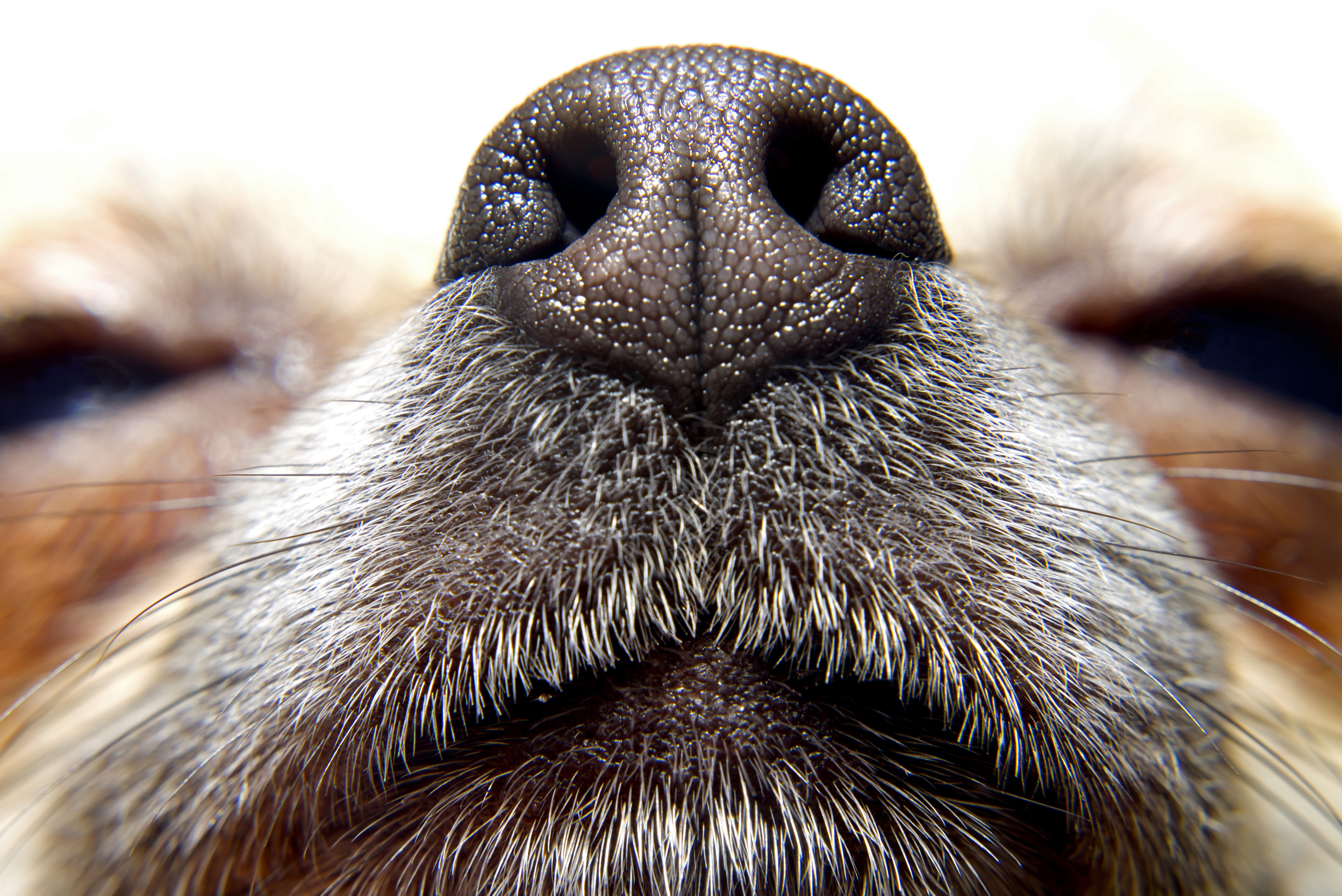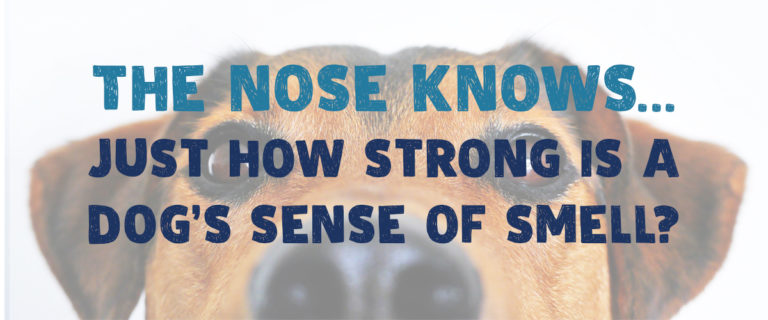How strong is a dog's sense of smell? If you've ever been on a walk and suddenly been pulled forward as your doggo starts taking off, nose to the ground, you'll know that dogs have a very strong sense of smell. You've probably seen this nose in action whenever you're making something tasty to eat or sitting down to a meal. From the moment food appears, your dog will magically appear, too, ready to sit at your feet and look up at you with big eyes. There's a reason we have K9 units, with dogs that are trained to sniff out bombs and assist with rescue operations.
With that said, while some breeds are extremely good at sniffing things out, others may not have the same abilities. Generally speaking, longer-nosed dogs such as German Shepherds, Belgian Malinois, Bloodhounds, Pointers, American Foxhounds, Bassets, and other dogs used for hunting or specific K9 duties are the best at smelling. Short-nose or flat-faced dogs like Pugs, English Bulldogs, Boston Terriers, Frenchies, Shih Tzus, Pekingese, Boxers, and Chows don't have a very good sense of smell due to their short nasal passages.
Wondering how dogs smell and how well dogs can smell? Keep reading to find out more about a dog's sense of smell.
We know you agree ... dogs are amazing. It’s hard to choose which canine characteristic is the coolest, however, at the front (no pun intended) is their sense of smell.

How strong is strong?
A dog's sense of smell overpowers a human’s by leaps and bounds; it's 10,000 to 100,000 times as acute, scientists say. James Walker, former director of the Sensory Research Institute at Florida State University, paints another picture. "If you make the analogy to vision, what you and I can see at a third of a mile, a dog could see more than 3,000 miles away and still see as well." This statistic explains why, when walking your dog, they stop to read their “pee mail” every few feet. Dogs can smell things that are invisible to humans. WOAH.
Why do dog noses work so much better than ours?
Adaptability. “Dogs noses are specifically adapted to function much better than ours,” explains Michael T. Nappier, DVM, DABVP, of the Virginia Maryland College of Veterinary Medicine. “They have up to 300 million olfactory receptors in their noses, versus only about 6 million for us. And the part of their brain dedicated to interpreting these is about 40 times larger than humans.” According to David C. Dorman, professor of toxicology at North Carolina State College of Veterinary Medicine, dogs have used their noses to assist with major life events since the beginning of time. “Evolutionarily, a dog’s sense of smell helps them find a mate, locate their puppies, food, and avoid predators."
Two functions. According to Nappier, a canine’s nose can separate air. A portion goes directly to the sense of smell receptors while the other part is for breathing.
Multitasking. "When sniffing, dogs noses are designed so that air can move in and out simultaneously, unlike humans who have to either breathe in or out only," says Nappier.
Special powers with 3D. The vomeronasal organ boosts a dog's sense of smell, says Nappier. It helps canines detect pheromones, chemicals released by animals that affect other members of the same species. Additionally, dogs can smell separately with each nostril. In humans, our eyes compile two slightly different views of the world, and our brain combines them to form a 3-D picture. Similarly, a dog's brain uses the different odor profiles from each nostril to determine precisely where smelly objects are in the environment.
How do dogs use their sense of smell to communicate?
What all of this sniffing and processing really means is that a dog's sense of smell is his primary form of communication. And it's a phenomenal one because dogs don't just smell odors that we can't. When a dog greets another dog through sniffing, for example, he's learning an intricate tale: his gender, what he ate, whom he met, what he touched, and what mood he's in. It's no wonder, then, that while a dog's brain is only one-tenth the size of a human brain, the portion controlling smell is 40 times larger than in humans.

As we alluded to earlier, when your dog stops to sniff during a walk, they're not taking a break. “Dogs read about the world through their noses, and they write their messages, at least to other dogs, in their urine,” according to dog book author Stanley Coren. It’s tempting to drag your dog along on a walk when he’s sniffing everything. However, you should give him a chance to read the neighborhood news, and let him do a little writing while he's at it.
What are some other cool things dogs do with their sense of smell?
Detect emotions: Research indicates that it's quite likely that a dog's sense of smell can pick up fear, anxiety, and even sadness. The flight-or-fight hormone, adrenaline, is undetectable by our noses, but dogs can apparently smell it. Also, fear or anxiety is often accompanied by increased heart rate and blood flow, which sends telltale body chemicals more quickly to the skin surface. Trying to mask your strong feelings with a casual smile may fool your friends, but it’s not going to fool a dog’s sense of smell.
Track Scents: Dogs whose olfactory skills are honed to work in a stressful environment, such as scent-tracking, are truly impressive canines. They are often called upon to track missing persons or find wanted criminals, and they must achieve their mission in strange environments and on the trail of unfamiliar people.
Keep the World Safe: Canines are often on the front lines in the military and police forces around the world, putting their noses to work for our benefit and safety. Some dogs are trained to find potential explosives before they detonate. Today, companies are working to develop dog breeds with enhanced olfactory capabilities, to accurately find people who are wearing body-worn and hand-carried explosives.
Assist Doctors: Recent research sheds light on a dog’s ability to sniff out diseases in humans, particularly cancers. Malignant tumors release minuscule amounts of chemical compounds that do not exist in healthy tissue. Dogs may be able to detect those changes long before they show up in a blood test. A study published in Integrative Cancer Therapies related how five trained domestic dogs were able to accurately identify lung cancer in 99% of patients and 88% of people with breast cancer by merely sniffing the patients’ breath. Additionally, a British study discovered that dogs are efficient in detecting sudden blood sugar drops in people with Type 1 diabetes. The research results noted that 65% of dogs warned their diabetic pet pawrents of the onset of a hypoglycemic attack by whining and barking.
Can some breeds detect smells better than others?
While all dogs have keen sniffers, Nappier says, "hound breed dogs have the best sense of smell." Dorman points out that sturdy working dogs like German Shepherds and Labradors also rank high in their smelling abilities.
Some dogs, like Pugs who have short faces, may "have some airway compromise that could affect their sense of smell," explains Nappier.
Is there a way to keep a dog’s sense of smell in shape?
In fact, there is: feed him a nutritious and wholesome diet. The other type of “food” for your dog’s nose is environmental enrichment. Take your dog to old and new locations, so he can expand his olfactory horizons. Walk on new routes, go to different parks, or hike some trails.
Now you know why your dog’s nose knows it all!
DISCLAIMER: These links are being provided as a convenience and for informational purposes only; they do not constitute an endorsement or an approval by Small Pet Select of any of the products, services or opinions of the corporation or organization or individual.
Interested in learning more about dogs? Check out these blogs!
How to Get Your Dog Used to Nail Clipping






